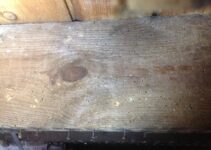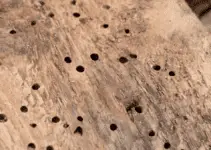For people who work with wood or own something made out of wood, and let’s face it that’s everybody, you’ll be aware of woodworm and the potential problem they pose.
For homeowners with structural timber or antique furniture, they’re a common enemy.
And what better way to outsmart your enemy than to know everything about them. Why? In order to outwit them, of course.
So if you have a problem with woodworm or want to know more about them, look no further. Today we’ll be looking more deeply into the life cycle of woodworm – specifically into the woodworm egg phase.
Common Furniture Beetle – aka Woodworm
You may not have learned Latin at school but there is at least one term to remember: Anobium Punctatum.
It’s the scientific name of the type of wood-boring beetle you’re most likely to come across – even if it’s only the destruction they’ve left behind.
Although there are other species of wood boring beetle, we’ll be focusing on this particular type as it is the pest you’ll probably be trying to irradicate or prevent from invading your home.
What Time of Year Do Woodworm Lay Eggs?
As with many animals, spring and summer are the times of the year that mating occurs. It’s at this point that adult beetles emerge from the wood that has been both their protection and main diet for the 2-5 years that they were in their larval stage.
They fly, in certain conditions, to new potential egg-laying sites, to mate and for the females to lay eggs.
The time to watch for emerging adults searching for a mate and a place to lay eggs is between May – August.
You may be able to trap the males using pheromone traps before they complete this part of their life cycle to prevent them from mating which, after all, is the beginning of the process of wood-based destruction.
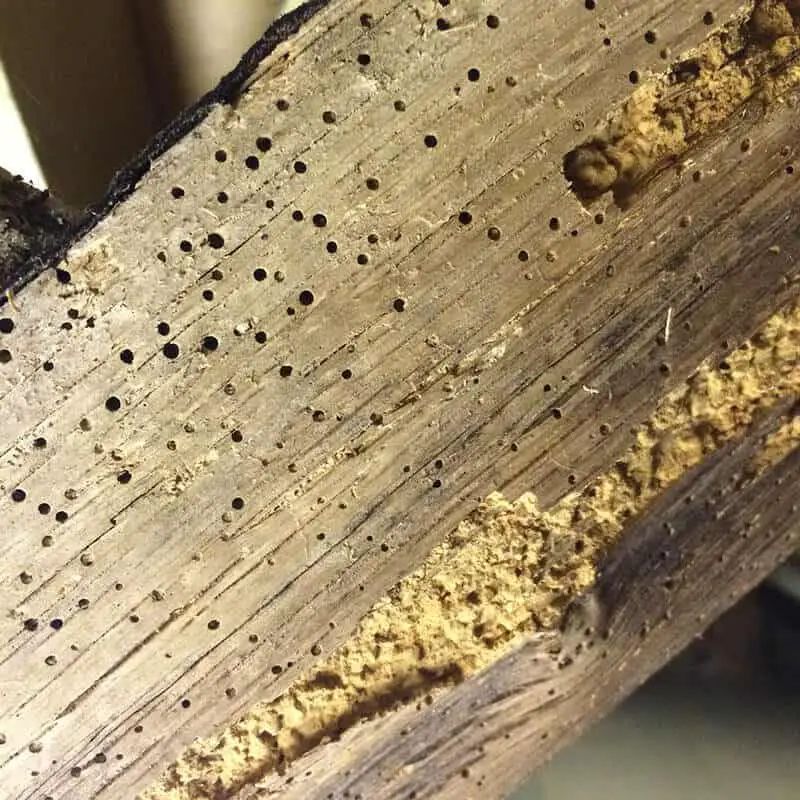
Where Do Woodworm Beetles Lay Eggs?
The sites where female beetles choose to lay their eggs will be in the many natural cracks that form in timber over time or that are created through damage.
Rough wood is a favourite for furniture beetles to lay eggs, as is the rougher end grain of finished wood.
Another key egg-laying site is in the joints between timber such as the meeting between joists and beams, joints in picture frames, chairs or any piece of furniture that is not made from a solid piece of wood.
It’s well known that furniture beetles love humid environments so any wood that is sited in damp conditions will be the biggest draw to a pregnant female.
And don’t forget to check old exit holes for eggs or larvae. Females will not miss the opportunity to use the old exit holes of emerged adult furniture beetles as a convenient and protected spot to lay their eggs.
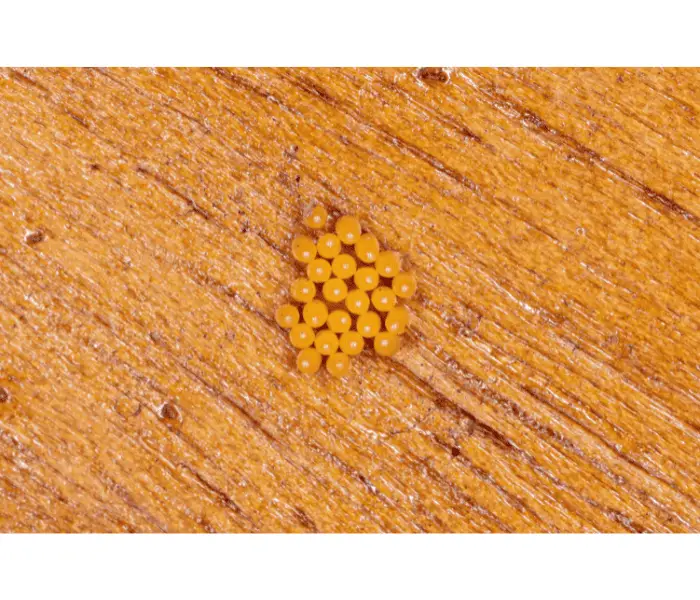
How Many Eggs Does a Woodworm Lay?
Female furniture beetles lay eggs in batches of 30 – 70. If flying conditions are not conducive, they may find a mate close to their hatching site and thus cut down on the risky and lengthy process of flight.
As male adults only live for a few days the imperative to reproduce is relatively strong. They can mate with multiple females during their adult lifespan which increases the chance of their fertilized eggs, carried by the female, continuing the life cycle.
The females, on the other hand, live for much longer, from 10 to 20 days. This means they have a greater chance of finding a suitable egg-laying site if the current environment has become unsuitable.
Can You See Woodworm Eggs?
Wood worm eggs are barely visible to the naked eye. Their proportions are 0.5mm x 0.3mm so you can imagine how hard they are to spot, especially as they are a creamy colour and pearl shaped so they blend in with the colour of many types of untreated timber.
Even in batches, they will be very hard to detect because the female will have situated the egg-laying site in a protected space which may be hard to get to.
Of course, knowing where potential egg-laying sites may occur will give a homeowner a useful place to test for woodworm or where to double up with preventative treatments.
Don’t expect to see them on treated timber as this is poisonous to them – unless, of course, the timber had been damaged and the treatment is shallow enough for the woodworm larvae to burrow deeper into the centre of the wood.
What Do Woodworm Eggs Look Like
As mentioned, because they’re difficult to see by the naked eye woodworm eggs are difficult to spot and often go unnoticed. But in terms of appearance they’re oval-shaped and typically a creamy white colour and about 1mm or less in size.
They are hidden in the cracks or pores of the wood, making detection even more challenging.
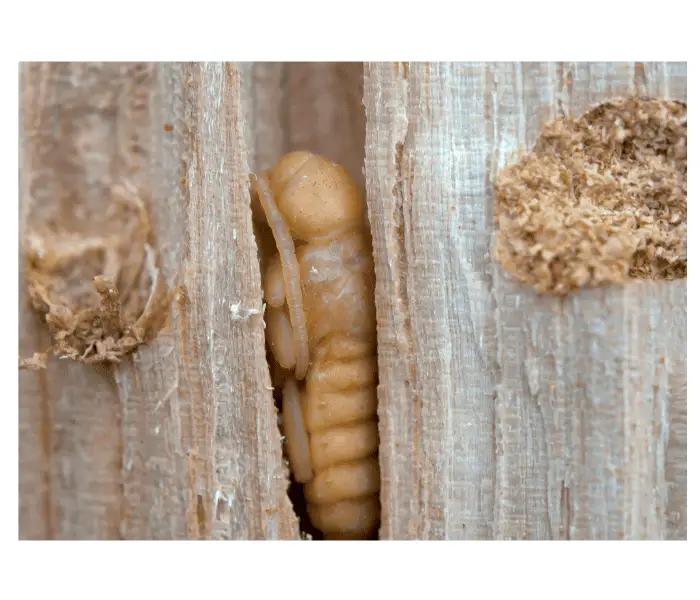
How Long Do Woodworm Eggs Last?
The time it takes for furniture beetle eggs to hatch is a contested one. However, the environment, timber type and the state of the timber seem to have an effect on the hatching time.
Once lain, woodworm eggs will hatch between 6 to 35 days into the larval stage and will immediately begin to eat down into the timber.
The important thing to note here is that even though the woodworm larvae do eat down into the wood, the external holes associated with the presence of woodworm are not the ones caused at this early stage in the life cycle.
The holes created by the larvae from freshly hatched eggs are at this stage not only minuscule but they are also backfilled with the residue of the timber they consume.
It is the exit holes of the emerging adult after the larval state that are more easily detected with the naked eye and by those without expertise.
Prevention and Treatment of Woodworm at the Egg Phase.
There are quite a few ways to prevent females from laying eggs or from mating in the first place, and you could try all or some of the following:
1. Keep your home warm and well-ventilated to stop humidity from building up. Humid and damp conditions are the most attractive for woodworm to thrive, mate and lay eggs.
2. Prevent eggs from being laid by treating all wood, where possible, with a barrier. Either this can be a specifically designed insecticide to prevent or treat woodworm or a more environmentally-friendly or natural barrier such as beeswax which woodworm hate.
3. If there are more humid or damp areas of your home that are difficult to heat or ventilate such as cellars or outbuildings, or in period homes where building modification is controlled, be vigilant regarding potential woodworm egg-laying sites and use preventative treatments were possible or allowed.
Woodworm Pheromone Traps
4. Males are attracted by the pheromones exuded by female furniture beetles. Use woodworm pheromone traps to attract males which kills them before they have a chance to mate.
Although designed for moths this will work just fine:
This will not totally prevent pregnant females from laying eggs but will reduce the potential of those females finding a mate.
While woodworm eggs may be hard to spot, it’s always worth maintaining your vigilance and preventing furniture beetles from laying eggs in the first place.
A careful application of a suitable barrier or treatment is a sound investment of your time as is maintaining a dry atmosphere in your home which will keep both your family happy and your timber woodworm-free.


